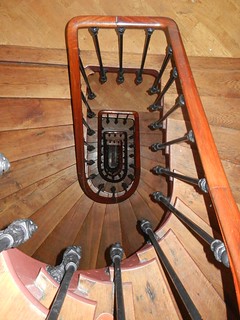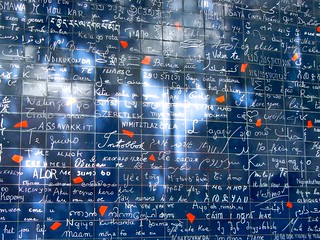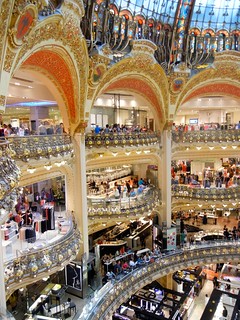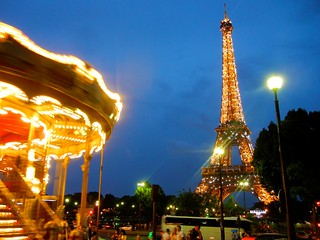Wi-Fi in Paris is as hard to come by as bathrooms in Reims (…and in Paris, for that matter). I write this in Amsterdam, which is covered in both Wi-Fi hotspots and (thank God) bathrooms, now marveling at any Internet connection speed greater than 1 Mbps. (To give an anchor, y’all, average connection speeds are around 25 Mbps. I was pulling my hair out.)
So here I am, Wi-Fi and all.
When I first stepped off the (early, early, early) train into Gare de l’est, my first feeling was one of relief: Whereas Charles de Gaulle -- Paris’s airport -- felt overwhelming when I’d first arrived a week and a half before, nothing felt new now. In the absence of more than basic French, I was used to scanning signs for illustrations to point me in the right direction; I’d picked up the right pace and mannerisms to keep my head down as I pushed my way through the crowds; I’d learned that Americans say “sorry” (désolée) and “excuse me” (pardon) far too unnecessarily.
And so it was that after five minutes of journeying through one of Paris’s largest train stations, I emerged onto a boulevard and felt another wave of relief. As though it had prepared me for what to expect in the coming days, Reims now seemed nothing more than a miniature Paris. The streets, architecture, signs, and people seemed almost identical, but on different scales -- and armed with at least three maps of Paris, I was ready to handle a super-sized Reims.
Meanwhile, Ryan was going through absolute torture to reach the same neighborhood of Paris. After taking a red-eye flight from Phoenix to London (without sleep) and a red-eye bus from London to Paris (with two hours of sleep), he was ready to curl up on the pavement and use his backpack as a pillow. Nevertheless, we met each other at the doorstep of our AirBnB in Montmartre, one of Paris’s more artistic neighborhoods perhaps a 10-minute metro ride from the Seine.
Nadia’s apartment was as Parisian as could be expected: After climbing eight sets of curling stairs (with luck, the elevator might have held one person), we walked into a single room with large windows that opened onto a large, sunny courtyard far below. The space was just as efficient as the rest of Europe -- Murphy bed, two small chairs and a table, a square-foot-sized kitchen area with a single stove eye and mini-fridge, and a tiny bathroom with a shower so small that I had to step out to turn around.
And it was lovely. So lovely, in fact, that we couldn’t resist leaving the windows wide open while we were there to tempt in a cool breeze and listen to the sounds of the neighborhood around us.
We stayed close to the apartment that first day and explored Montmartre in all its historic, cobblestoned glory. Unlike many parts of the city, these streets were narrow -- only fitting one car and a sidewalk at a time (and the French love their lane-sized sidewalks and lane-sized bike paths that take up half of any given road). Balconies were lined with flowers and ivy, iron patio tables clustered around corner bistros, and we could hear the distinct sound of an accordion far off in the distance. It might have been a set for “Midnight in Paris”.
After grabbing some much-needed caffeine from Coquelicot, we visited the Wall of Love -- a tile wall that features words of love from more than 300 languages around the world -- and hiked our way up the 270-stair climb to Sacré-Cœur, France’s most famous basilica that boasts one of the largest bells in the world (i.e., 19 tons). From the summit, we could look out over Paris where it stretched into the far distance…and as the days passed, many times we could look toward the horizon and see Sacré-Coeur where it sat overlooking the city below.
 We wandered into Saint Pierre de Montmartre, which was first built as an abbey in 1133, and strolled through the artist-filled Place du Tetre where it lay nestled in a tree-covered plaza. A narrow alley led us past Erik Satie’s house, where a young man sat playing a cello with loving tenderness, before we headed up to Picasso’s studio around the corner and wound our way back down the hill to gaze up at Moulin de la Galette, a windmill and restaurant that served as the site of Renoir’s famous painting.
We wandered into Saint Pierre de Montmartre, which was first built as an abbey in 1133, and strolled through the artist-filled Place du Tetre where it lay nestled in a tree-covered plaza. A narrow alley led us past Erik Satie’s house, where a young man sat playing a cello with loving tenderness, before we headed up to Picasso’s studio around the corner and wound our way back down the hill to gaze up at Moulin de la Galette, a windmill and restaurant that served as the site of Renoir’s famous painting.
That afternoon, we visited one of Ryan’s only non-museum requests: Galleries Lafayette, a six-story department as ornate as many churches I’d seen in France. If Barney’s is known for its fancy designers (few of which I’d ever heard), Galleries Lafayette would be known for its fancy…everything. Instead of separating between stores within the mall, each store was given a booth -- a Ralph Lauren booth (swoon), a Gucci booth, a Prada booth, even a Starbucks booth that had the nerve to sell 16.9-oz bottles of water for more than $4. Best of all, you could climb to the sixth floor and look out over the mall around you as it lay sprawling beneath a massive skylight.
Because we’re so far north, Paris doesn’t grow dark until 9:15 or 9:30 p.m. (I write this from Amsterdam, of course, where it’s 10 p.m. right now and I’m working only from natural light outside, which will be the case until around 10:30.) So even after dinner, there was plenty of light to take the metro to the Arc de Triomphe, symbol of Napoleon’s 1806 victory over Austerlitz, before strolling down the Champs-Élysées -- regarded as one of the most famous streets in the world.
Side note: I’m not entirely sure why Champs-Élysées (SHON-sell-e-say) still boasts so much fame when the history that made it famous isn’t even recognizable today. On the one hand, it does connect the Arc with the Obelisk of Luxor (originally located in the entrance to Egypt’s Luxor temple) and on to the Place de la Concorde, site of many public executions including that of Marie Antoinette. So yes, much history -- very little of which is actually conveyed during that walk. On the other hand, it now feels similar to Rodeo Drive, or maybe an upscale commercial street with many Westernized shops and chains.
Then again, never in my life have I complained about upscale commercial streets with Westernized shopping options.
I’m missing my point.
And then, when we’d reached the obelisk and began to wind our way past the royal palace and toward the Seine, we saw it. It loomed over the five-story buildings, vanishing gradually as we drew closer. We made one turn after the next, tripping over cobblestones as we kept our gazes fixed on the sky, and then -- after making one chance turn -- we saw it.
The Eiffel Tower stood, as regal as the pictures have made it seem, beyond a long stretch of perfectly green lawns and manicured shrubs. These lawns were dotted with picnickers, couples, and selfie-taking teens, all of whom seemed to be waiting for something to happen.
Within moments, it became clear that the Eiffel Tower is just as tall as I’d hoped it might be -- and it’s beautiful. More beautiful than Google portrayed, and more special than I thought I would find such a cliché world landmark. And just as we’d taken a round of selfies only dozens of feet from where it stood, we heard gasps, applause, and cheers.
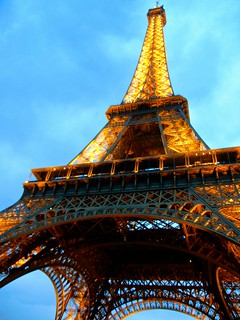 The sky was, at that point, beginning to darken into a deep violet, and the Eiffel Tower now stood out as clearly as day: It was lit up from top to four-footed bottom and sparkling with flashing lights. We passed under the structure and climbed Trocadéro Gardens to gaze out at this spectacle as the Fountain of Warsaw played out its timed water show. Nothing could have been more perfect.
The sky was, at that point, beginning to darken into a deep violet, and the Eiffel Tower now stood out as clearly as day: It was lit up from top to four-footed bottom and sparkling with flashing lights. We passed under the structure and climbed Trocadéro Gardens to gaze out at this spectacle as the Fountain of Warsaw played out its timed water show. Nothing could have been more perfect.
And then, thoroughly exhausted (in Ryan’s case, with only a few hours’ sleep in three days), we made our way back to the apartment, opened the windows to let in the night breeze, and started planning our next day.

